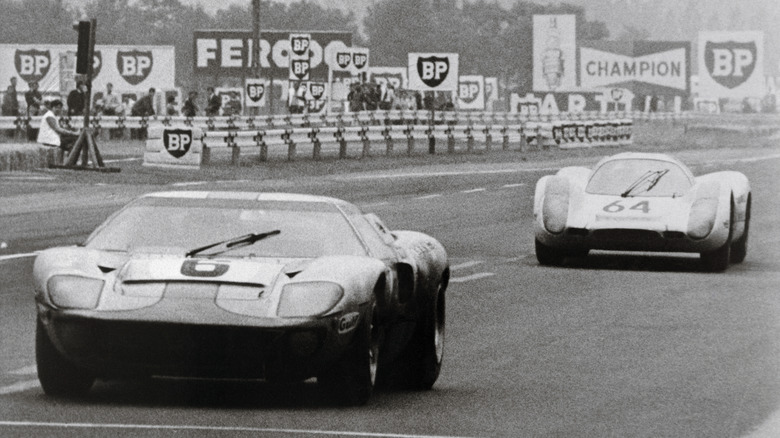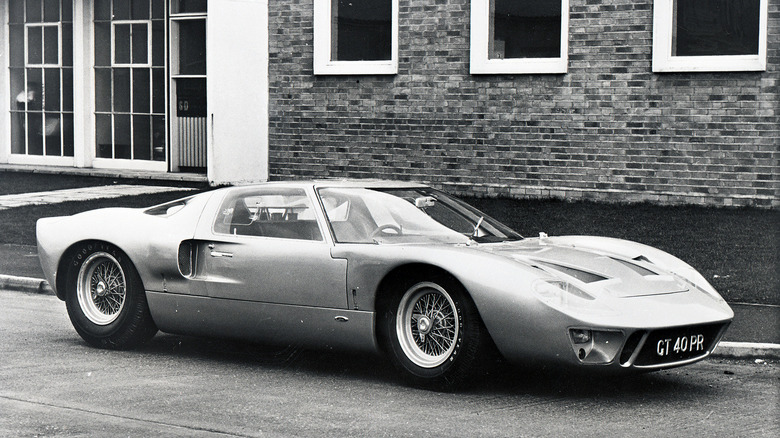Why Tracking How Many Ford GT40s Were Made In The 1960s Proves So Difficult
Few race cars command such respect as the Ford GT40. It was hard-won, with the vehicle becoming the first American-made car to win the famous 24 Hours of Le Mans, and then not just once, but four consecutive times, between 1966 and 1969. With Daytona, Sebring, and many more — GT40s boast among the finest racing records in all of motorsports. People still actively compete with original and replica platforms in various classic racing series today, from sprint races to full-fledged multi-hour endurance racing. Why, then, is it so hard to keep track of something so prestigious?
In short, it's because GT40s weren't built as bespoke collector's items like many of today's fastest hypercars — they were pure-blooded race cars. They were driven hard, sometimes crashed out, repainted, upgraded with better components as they became available, and so on. Six decades on, and many of the cars have passed through innumerable hands creating a labyrinth of research for each vehicle — and that's before introducing registered GT40 replicas into the equation. Let's dive deeper and explore the challenge faced by today's GT40 collector community.
Keeping an accurate record
The need for the GT40 arose because of Ford's desire to build a vehicle to directly compete with Ferrari, a legacy chronicled in books, films, and popular media ever since. As a result, GT40s are among the most recognizable race cars in history — though they are certainly not all the same. Estimates put the number of Ford GT40s in the original effort to overcome Ferrari at 105 cars, split into a dozen prototypes, and the differences don't end there.
Even within the same Mark variant teams changed components as new parts became available. For example, early GT40s feature various aerodynamic and bodywork alterations performed by Ford and Shelby to optimize its shape, which means that many feature different panels and other parts depending on the year. Similarly, Marks can be subdivided into various categories, such as: which cars were produced where, road and racing variants, and which used certain components like specific engines. Not all of the GT40s from the 1960s were even called "GT40."
It's not impossible to catalogue all of these discrepancies, but it does prove challenging to research a specific car's history when, for instance, it's a Mark IV that looks completely different to another Mark IV. This effectively makes each GT40 unique, and a challenge for restoration.
Built for a purpose
The GT40 remains singular in function. As these vehicles are designed for racing, it's no surprise that they often get raced. They make exceptional track cars; if you look up videos of GT40s, the vast majority of them take place on a racing circuit, and that's where they're happiest. They're not practical classic cars for daily-driving – Ford barely managed to sell the road versions brand-new even after deep discounts – by all accounts, they're loud and obnoxious to drive like normal cars.
In terms of collectability, the GT40s from the 1960s fall into a strange middle-ground. Collectors typically favor two main options, long-term parking, or using them as track cars. As it was built for endurance racing, the GT40 is one of the few collector cars that doesn't suffer from hard miles. This results in it changing hands through private sales. Some take decades to restore while passing through multiple owners, further complicating the accurate tracking of each version.
That said, if you have about $10 million sat in your wallet for a GT40, none of this should dissuade you. Despite their eccentricities, these cars remain among the most prized classics that still appear for sale with any regularity.


